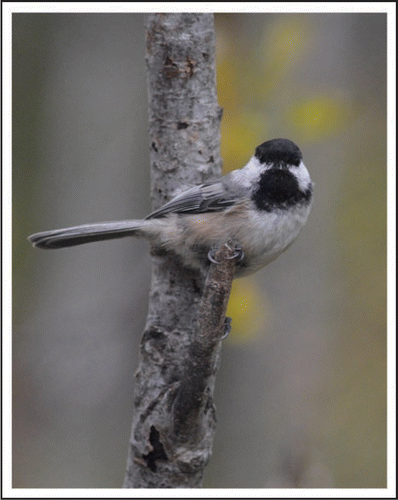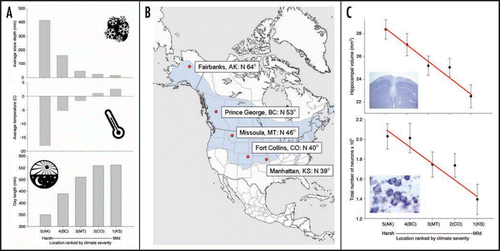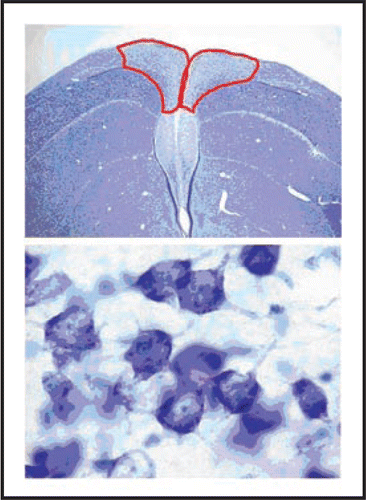Abstract
Memory is crucial for survival in many animals. Spatial memory in particular is important for food-caching species and may be influenced by selective pressures such as climate. The influence of climate on memory may be facilitated through the hippocampus (Hp), the part of the brain responsible in part for spatial memory. In a recent paper, we conducted the first large-scale test of the relationship between memory, the climate, and the brain in a single food-caching species, the black-capped chickadee (Poecile atricapillus). We found that birds from more harsh northern climates had significantly larger hippocampal volumes and more neurons than those from more mild southern latitudes. This work suggests that environmental pressures are capable of influencing specific brain regions, which may result in enhanced memory, and hence survival, in harsh climates. This work gives us a better understanding of how the brain responds to different environments and how animals can adapt to their environment in general.
Introduction
Memory is important for survival. Whether used to find food, recognize conspecifics, recall dangerous situations or navigate through territories, memory plays an important role in the behavior of many animals. Still, it is not clear how selection influences memory, its underlying neural mechanisms, and which specific pressures might be most relevant to produce changes in memory function.
Memory and its mechanisms have been particularly well studied in food-storing animals. Many species store (or cache) excess food during the fall to use during the winter when naturally available food is in short supply. Some species of birds, for example, can make well over 10,000 caches in a single fall season and rely completely on this cached food for the duration of the winter. Since many food-storing species are also non-migratory, food caching is likely an adaptation to survive harsh winter conditions.Citation1–Citation4 Cache retrieval is facilitated at least in part by memory, of which spatial memory appears to be particularly important.Citation1,Citation2,Citation5 As a result, the spatial memories of these species are incredibly acute.
For food-caching species, climatic severity has been suggested as one possible selective factor affecting memory.Citation1,Citation2,Citation6 TheoryCitation4 predicts that selection on cache retrieval ability is a function of environmental severity. Thus, food-caching animals living in harsh environments that demand more food during the winter should rely more on cached food than those living in mild conditions, and so should have better memories to support more efficient cache retrieval. Consequently, these animals may benefit from more neurons within a larger hippocampus (Hp), a part of the brain involved in spatial memory processing. This is the crux of the adaptive specialization hypothesis, which states that morphology and/or behavior can be modified if it enhances fitness.
Testing the Adaptive Specialization Hypothesis
The importance of the Hp for spatial memory has been well demonstrated,Citation2,Citation7,Citation8 and the volume of the Hp has been directly related to memory capability.Citation1 Thus, we compared the Hp volume and total number of Hp neurons () in a single species, the black-capped chickadees (Poecile atricapillus; ), on a large geographical scale at five locations along a gradient of environmental harshness across its range in North America ().Citation9 We found that black-capped chickadees in harsh climates of the north had larger relative Hp and more Hp neurons than their conspecifics in more mild, southern climates () These results follow the predictions generated from the adaptive specialization hypothesis exactly; however, at this point we cannot establish whether these differences are inherited or produced by different memory use (i.e., experience) in these environments. Future work should be able to resolve this question.
Memory, the Environment and the Brain
Much of the previous work in the food-caching paradigm that attempts to relate the brain and memory with caching has tried to explain the variation in the Hp volume across species of food-caching and non-food-caching birds species by relating Hp volume to rough estimates of caching intensity. While this interspecific variation in the Hp volume may be potentially explained by the adaptive specialization hypothesis, support for the hypothesis in general terms is unclear. Many interspecific studies fail to find any consistent patterns.Citation10–Citation14
These inconsistencies in the relationship between Hp volume and memory may be due in part to variation in the data collection and methodology of numerous independent studies, as well as ecological confounds and invalid assumptions related to phylogeny and the phenotypes of ancestral species.Citation15 By using a single species comparison, we reduced the problems of phylogenetic history and numerous confounding ecological variables. Moreover, by comparing data within a single study, we can be certain that those data were collected in the same way and are, thus, comparable. In addition, many of the interspecific studies considered only volumetric measurements of the Hp while ignoring the number of neurons, which might be a better indicator of hippocampal function.Citation16
Finally, many of these previous studies used a categorized scale of caching intensity as their independent variable. The relevance of caching intensity is not clear for the adaptive specialization hypothesis. While caching intensity may potentially correlate with environmental conditions, the severity of the environment seems to be a better predictor of the degree of potential dependency on cached food for survival. Ultimately, it is not the number of caches made in a given time frame, but the ability of the animal to accurately retrieve those caches that is likely most crucial for fitness. It is this ability to retrieve caches during demanding times that may connect the environment with memory and the brain.Citation17
Overall, the results of our recent study provide strong support for the adaptive specialization hypothesis. The relationship between Hp structure and climate seems robust on a large geographic scale, which supports the hypothesis that environmental conditions demanding better memory for survival result in an enlarged hippocampus with more neurons. This work also suggests that environmental pressures such as climatic harshness are capable of influencing specific brain regions (in our case the Hp) independently of others. In addition, previous work suggests that birds from the more harsh climates had better spatial memory than those from the milder climate.Citation17 Thus, there is good evidence that the result of the effect of climate on the brain is enhanced memory, which very likely results in enhanced survival in these harsh climates.
We are now in a position to expand this line of work to experimentally tease apart different potential selection pressures and processes. For example, while our original determination of climate included various factors (day length, temperature, snow fall), we can now determine the relevance of some of these variables for selection. By comparing locations with very different climates at the same latitude (e.g., Washington and Minnesota), for example, we can control for the effect of day length. Similar tactics can be used to dissociate vegetation types and complexity. In addition, there is the possibility of dissociating the influences of genetics and experience with common garden studies. As chickadees tend to take well to captivity, various laboratory-based experiments could be done to further explore the effects of climate on the brain and memory.
Figures and Tables
Figure 2 The black-capped chickadee (Poecile atricapillus) is a non-migratory food-caching bird commonly used in studies on the relationship between the environment, the brain and memory. Photograph by TCR.

Figure 3 (A) Locations ranked by climatic severity based on winter period (Nov–March) averages from 1971–2000. Average winter temp (C), average snow depth (mm) and day length (min) during winter solstice. All measures of climate severity decrease as latitude decreases. Data from Roth and Pravosudov.Citation9 (B) Map of black-capped chickadee species range and collection sites across North America. (C) Relative hippocampal volume and total neuron numbers (least squares means) across locations ranked by climate severity. Both chickadee Hp volumes and neuron numbers significantly decreased with latitude and climate severity and correlated perfectly with rank climate variables. Data from Roth and Pravosudov.Citation9

Addendum to:
References
- Krebs JR, Sherry DF, Healy SD, Perry VH, Vaccarino AL. Hippocampal specialization of food-storing birds. Proc Natl Acad Sci USA 1998; 86:1388 - 1392
- Sherry DF, Vaccarino AL, Buckenham K, Herz RS. The hippocampal complex of food-storing birds. Brain Behav Evol 1989; 34:308 - 317
- Pravosudov VV, Grubb TC. Management of fat reserves and food caches in tufted titmice (Parus bicolor) in relation to unpredictable food supply. Behav Ecol 1997; 8:332 - 339
- Pravosudov VV, Lucas JR. A dynamic model of short-term energy management in small food-caching and non-caching birds. Behav Ecol 2001; 12:207 - 218
- VanderWall SB. Food hoarding in animals 1990; Chicago University of Chicago Press
- Sherry DF, Jacobs LF, Gaulin SJC. Spatial memory and adaptive specialization of the hippocampus. Trends Neurosci 1992; 15:298 - 303
- Sherry DF, Vaccarino AL. Hippocampus and memory for food caches in black-capped chickadees. Behav Neurosci 1989; 103:308 - 318
- Hampton RR, Shettleworth SJ. Hippocampal lesions impair memory for location but not color in passerine birds. Behav Neurosci 1996; 110:831 - 835
- Roth TC, Pravosudov VV. Hippocampal volume and neuron numbers increase along a gradient of environmental harshness: a large-scale comparison. Proc R Soc B 2009; 276:401 - 405
- Shettleworth SJ. Alleva E, Fasolo E, Lipp HP, Nadel L, Ricceri L. Memory in food-storing birds: from the field to the Skinner box. Behavioral brain research in naturalistic and semi-naturalistic settings 1995; The Hauge, the Netherlands Kluwer 158 - 179
- Bolhuis JJ, Macphail EM. A critique of the neuroecology of learning and memory. Trends Cogn Sci 2001; 4:426 - 433
- Macphail EM, Bolhuis JJ. The evolution of intelligence: adaptive specializations versus general process. Biol Rev 2001; 76:341 - 364
- Brodin A, Lundborg K. Is hippocampal volume affected by specialization for food hoarding in birds?. Proc R Soc B 2003; 270:1555 - 1563
- Brodin A, Bolhuis JJ. Memeory and brain in food storing birds: space oddities or adaptive specialisations?. Ethology 2008; 114:633 - 645
- Roth TC, Brodin A, Smulders TV, LaDage LD, Pravosudov VV. Processes underlying volumetric changes in the hippocampus. Phil Trans R Soc B 2010; Proposal accepted
- Roth G, Dicke U. Evolution of the brain and intelligence. Trends Cogn Sci 2005; 9:250 - 257
- Pravosudov VV, Clayton NS. A test of the adaptive specialization hypothesis: Population differences in caching, memory and the hippocampus in black-capped chickadees (Poecile atricapilla). Behav Neurosci 2002; 116:515 - 522
